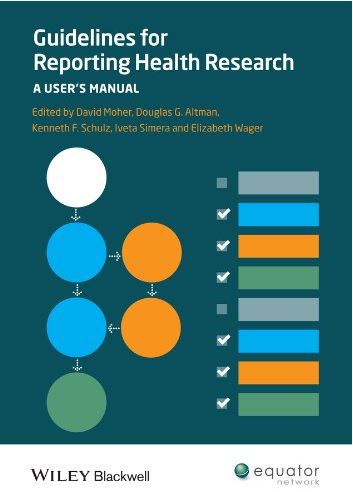EQUATOR Network reporting guideline manual
 Written by the authors of health research reporting guidelines in association with the EQUATOR Network, Guidelines for Reporting Health Research: A User’s Manual is a practical guide to choosing and correctly applying the appropriate guidelines when reporting health research to ensure clear, transparent, and useful reports.
Written by the authors of health research reporting guidelines in association with the EQUATOR Network, Guidelines for Reporting Health Research: A User’s Manual is a practical guide to choosing and correctly applying the appropriate guidelines when reporting health research to ensure clear, transparent, and useful reports.
Inside Guidelines for Reporting Health Research, you’ll find:
- An introduction to reporting guidelines;
- Why transparent reporting is important;
- The characteristics of good reporting guidelines;
- How to effectively use reporting guidelines when writing about health research; and
- 22 internationally recognised published guidelines, such as CONSORT, STROBE, PRISMA, and STARD, in a clear and easy-to-understand format.
We hope that authors, editors, and peer reviewers will find Guidelines for Reporting Health Research to be a valuable resource when writing about and publishing health research.
You can purchase the textbook here.
Sample chapters
- Chapter 1 (PDF): Doug Altman and David Moher explain why we need health research to be transparently reported
- Chapter 4 (PDF): Doug Altman and Iveta Simera show how reporting guidelines can be used to properly report your health research
- Chapter 5 (PDF): Kenneth Schultz, David Moher, and Doug Altman talk about the differences between reporting and conduct
- Chapter 17 (PDF): Myriam Cevallos and Matthias Egger introduce the STROBE reporting guideline (STrengthening the Reporting of Observational studies in Epidemiology)
- Chapter 29 (PDF): Jason Roberts, Timothy Houle, Elizabeth Loger, Donald Penzien, Dana Turner, and John Rothrock explain how to establish a reporting guidelines policy in your health journal
Reviews
Hayley Tyrer reviews Guidelines for Reporting Health Research on the BioMed Central blog network:
I found the book to be well written and chapters could easily be read as stand-alone items if required, due to each chapter dealing with a single guideline or idea… On a personal level, I found the included examples illustrating good and bad reporting versus good and bad conduct, particularly useful. The closing chapters outlining how to report statistical analyses within research manuscripts and tips for the presentation of figures and clinical images in scientific manuscripts were also excellent.
Although this book is suitable for all researchers, it will have the most impact on researchers who use a variety of study designs in their investigations… Journal editors, editorial board members, and publishers would all benefit from keeping a copy of this book on hand. Finally, trainees interested in clinical research would benefit from reading this book from cover to cover as it will help them acquire a firm understanding of the best reporting practices for most types of clinical research.
